The Beginnings
- Cowes - Southampton Route
Hovercraft around the Globe
Time For a Change
The Next Step
A New Direction
Hovertravel first started operations in July 1965. Two 38 seat SRN6 Hovercraft were Leased from The British Hovercraft Corporation in East Cowes, Isle of Wight.
Initial services ran between Ryde, Southsea and Stokes Bay in Gosport. This new form of transport had immediate appeal, with queues forming to buy tickets whilst the captains were still collecting the craft from the factory!
Initially the plan was to run a seasonal summer service to provide a unique experience for tourists both on the Isle of Wight but also the south of England, however, over time the number of regular travellers and commuters grew to the extent that year round service became viable and remains to this day.
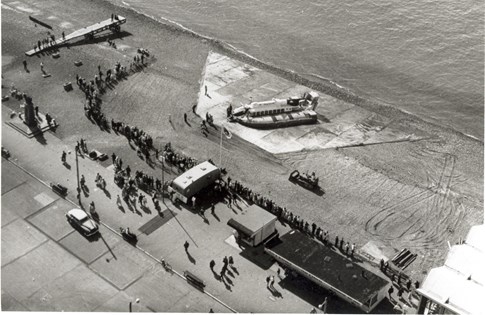
SRN6 Hovercraft at Southsea in 1965
Started by British Rail under the name Seaspeed, the Cowes-Southampton route ran for many years, also using the SRN6. This route was considerably longer than the Hovertravel routes, taking approximately 20 minutes to make the crossing.
The lack of shallow water meant that this route was open to competition from other types of high-speed vessels such as hydrofoils and catamarans. Eventually Hovertravel took over the running of this route on behalf of Seaspeed, however the rising costs and increased competition meant that the decision was taken to cease this operation in 1980 and concentrate resources on the more successful Ryde-Southsea service.
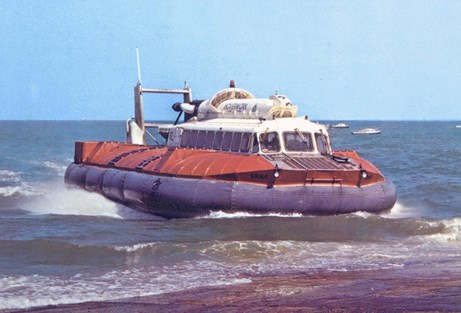
SRN6 Key Facts
- 38 Seats
- 14.76m in Length
- 7m Width
- Single 900HP Rolls Royce Gnome Gas Turbine engine
- Single Dowty-Rotol Variable Pitch Propeller
- The first mass production hovercraft, built and used all over the world
Early interest in hovercraft resulted in Hovertravel becoming involved in charter operations all around the world. Proving particularly useful in oil exploration and seismographic surveys, these operations often found hovercraft working in deserts, frozen arctic regions as well as areas previously unexplored. In 1968 a Hovercraft expedition famously caught on camera, saw a single SRN6 make the perilous journey to explore the Amazon an Orinoco Rivers. Successfully crossing rapids and reaching areas that few people had seen.
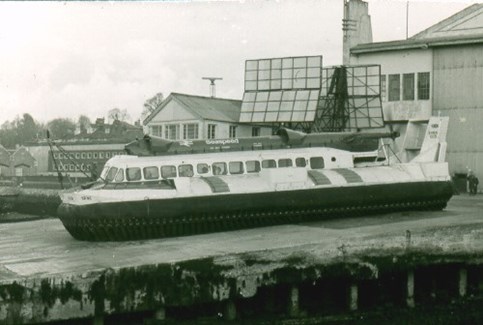
SRN6 MK1 Key Facts
- 58 Seats
- 17m Length
- 7m Width
- Single 1000HP Rolls Royce Gnome Gas Turbine engine
- Single Dowty-Rotol Variable Pitch Propeller
- During the 70s the original SRN6 was stretched to increase capacity by 20 seats with only a slight increase in engine power
- Seen here leaving factory in British Rail Seaspeed colours
Successful as the SRN6 had been, as the 70s drew to a close it became apparent, that if hovercraft were to continue operating commercially a new and radically different design was needed.
Despite improvements to the original design the SRN6 was still noisy and becoming increasingly expensive to maintain due to the aircraft technology required.
New technologies were now available, and the combination of improvements in skirt design and the availability of high-speed air-cooled diesel engines meant that the idea of a large diesel-powered amphibious hovercraft was now possible, so the designers got to work.
The result was the first AP1-88 hovercraft ‘Tenacity’ which after extensive trials, entered service with Hovertravel in 1983.
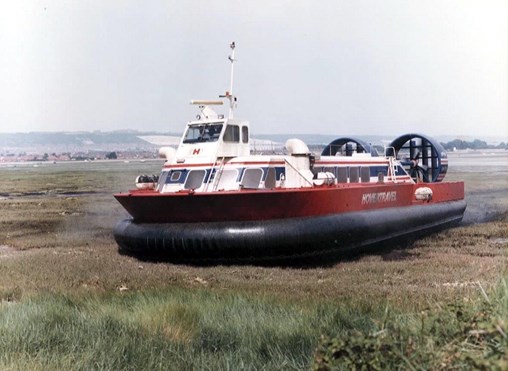
AP1-88/100 Key Facts
- 80 Seats
- 21.5m Length
- 10.06m Width
- Four Duetz air-cooled diesel Engines
- Two Hoffmann Fixed-Pitch Propellers
- Once described as a ‘High Flying Boat rather than a low flying aircraft’ The quieter and more economical AP1-88 type hovercraft gave the hovercraft industry a new lease of life
The arrival of more advanced water-cooled engines in the 90s led Hovertravel to further improve the AP1-88, stretching the back end enough to fit 800 HP MTU engines, the improvement in performance and reliability was remarkable, this coupled with a marked reduction in noise resulted in a number of other craft going through this conversion, named AP1-88/100s.
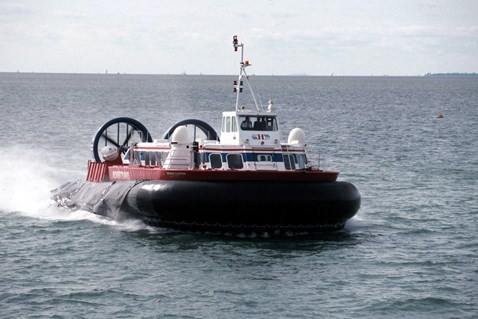
AP1-88/100 Key Facts
- 98 seats
- 24.5m Length
- 11m Width
- Four Duetz air-cooled diesel Engines
- Two Hoffmann Fixed-Pitch Propellers
- The Original AP1-88 Was made longer, with uprated engines and a considerably larger skirt. This new craft out-performed those previously used on the route but the improvements didn’t end there….
The arrival of more advanced water-cooled engines in the 90s led Hovertravel to further improve the AP1-88, stretching the back end enough to fit 800 HP MTU engines, the improvement in performance and reliability was remarkable, this coupled with a marked reduction in noise resulted in a number of other craft going through this conversion, named AP1-88/100s.
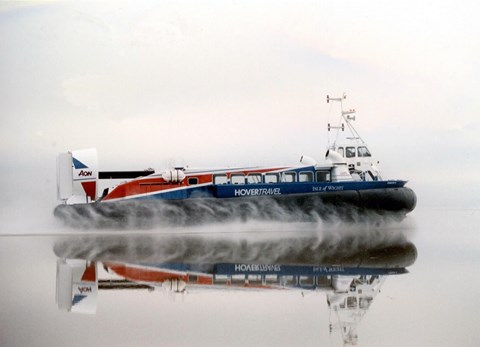
AP1-88/100 Key Facts
- 95 Seats
- 25.4m Length
- 11m Width
- Two Duetz air-cooled diesel lift Engines
- Two MTU 800 HP Water-cooled Propulsion Engines
- Two Hoffmann Fixed-Pitch Propellers
- Freedom-90 was the first craft to be converted, note the large carbon fibre drive shafts and colour scheme for the 1999 Golf open.
By this time Hovertravel was carrying almost 1 million passengers a year, running every 15 minutes during busy times, so thoughts turned to the future and finding a suitable replacement for the AP1-88s.
The opportunity arose when an American company put in an order for a considerably larger hovercraft for use in the Aleutian Islands in Alaska.
Built under licence in the USA this new design was named the BHT-150, utilising 4 Detroit water- cooled engines, SUNA-X would be the largest diesel hovercraft so far at 30 metres long.
Back on the Isle of Wight the design team turned their attention to producing a passenger version, the BHT-130. This would be capable of carrying 130 passengers and operate in nearly all-weather conditions.
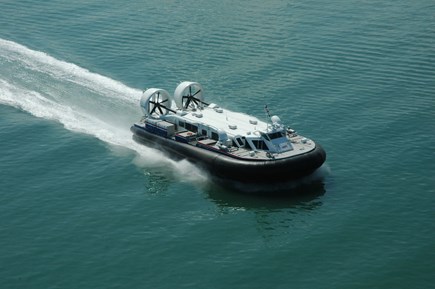
BHT-130 Key Facts
- 133 Seats
- 27.5m Length
- 12m Width
- Four Detroit water-cooled Engines
- Two Hoffmann Variable-Pitch Propellers
- The largest amphibious hovercraft operated on the Ryde Southsea Route, Solent Express offered improved passenger comfort and weather limitations than previous designs.
This new craft was operated for four years, however, proved to be un-economical for a relatively short route, being nearly twice the weight of the AP1-88s. The BHT-130 was clearly better suited to longer routes, where sea conditions are more significant, this was proven during a very successful operation in Edinburgh where Solent Express carried 32,000 passengers in just three weeks of running in some very challenging conditions. Eventually the decision was taken to look for a hovercraft more suited to the Isle of Wight market and Solent sea conditions.
Hovertravel was now under new ownership, Bland Group Holdings was a family owned organisation that had been involved with Hovertravel from the beginning, and now became the sole owners.
This led to re-think of the company’s role, studies were carried out of customer expectations, studies predicted the ideal of size of hovercraft most likely to provide a sustainable and profitable future for the company with a view to setting Hovertravel on a path that would secure it’s future for many years to come.
At the same time, different types of hovercraft were looked at to see what was now technically possible, improvements in passenger experience, noise levels and manoeuvrability were all identified as well as the need for greater accessibility for customers, luggage and freight.
Working closely with the sister company Griffon Hoverwork, a design was drawn up for a new twin diesel engine hovercraft. Named the 12000TD this would be the quietest and most economically viable craft so far, carrying 80 passengers, with larger windows giving clearer views. Production started in 2015 with a view to entering service during 2016.
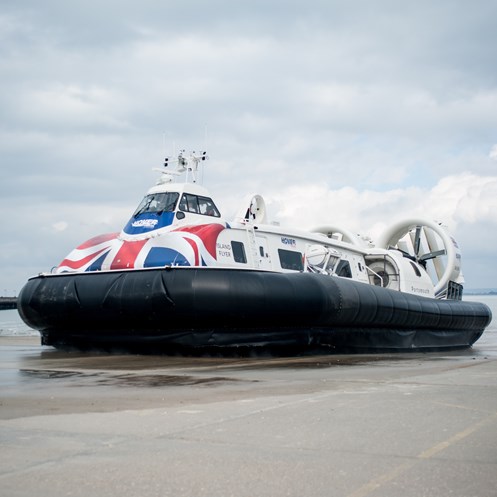
GHW 12000TD Key Facts
- 78 Seats
- 21.5m Length
- 11m Width
- Two MAN 1100HP water-cooled diesel Engines
- Two MT Variable-Pitch Propellers
- Entering service in 2016 the two GHW12000TD craft where the first purpose-built passenger to be produced for many years and are proving to be exactly what is needed to ensure that Hovertravel will prosper for future generations to enjoy.
So from history we now look to the future, and the hovercraft lives on, going from strength to strength. Making the most of new technologies, new lighter materials and new understandings to create a hovercraft that can provide a viable alternative to other forms of water-borne transport. Paving the way, once again for potential operators around the world to enjoy the benefits of this unique form of transport that Solent travellers enjoy every day.
